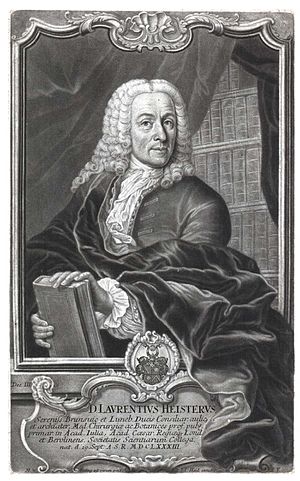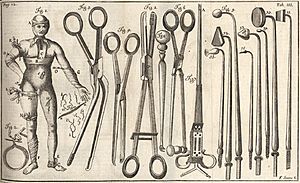Lorenz Heister facts for kids
Quick facts for kids
Lorenz Heister
|
|
|---|---|
 |
|
| Born |
Lorenz Heister
19 September 1683 |
| Died | 18 April 1758 (aged 74) |
Lorenz Heister (whose Latin name was Laurentius Heister) was a German doctor, surgeon, and plant expert. He was born in Frankfurt am Main on September 19, 1683. Heister made many important discoveries and improvements in medicine during his life. He passed away on April 18, 1758.
Contents
Early Life and Studies
From 1702 to 1706, Lorenz Heister studied at the Universities of Giessen and Wetzlar. After that, he moved to Amsterdam. There, he learned about anatomy, which is the study of the body's structure, from a famous expert named Frederik Ruysch.
In the summer of 1707, Heister worked as an assistant doctor in field hospitals. These were temporary hospitals set up during the War of the Spanish Succession near Brussels and Ghent. He then traveled to Leiden to continue his studies. He learned more about anatomy and also attended lectures on chemistry and eye diseases. In 1708, he earned his doctorate degree from the University of Harderwijk.
Military Surgeon and Professor
In the summer of 1709, Heister joined the Dutch military again. He worked as a field surgeon during the Siege of Tournai. Soon after, he became well-known for how well he treated soldiers wounded in the Battle of Malplaquet.
In 1711, Heister became a professor of anatomy and surgery at the University of Altdorf. Later, in 1720, he moved to the University of Helmstedt. He stayed there for the rest of his life. At Helmstedt, he taught classes on anatomy, surgery, botany (the study of plants), and practical medicine. In 1730, he was chosen to be a Fellow of the Royal Society, which is a group of important scientists.
Important Contributions
Lorenz Heister wrote many books. His most famous book is called Chirurgie, which means "Surgery." This book was translated into many languages and was used by doctors for a very long time. It was even used as a standard textbook in Vienna until 1838.
Heister was also a plant enthusiast. His botanical garden in Helmstedt was considered one of the most beautiful in Germany.
In 1718, he created the word "tracheotomy." This is a medical procedure where a cut is made in the windpipe to help someone breathe. He is also known for being the first doctor to perform a post-mortem examination (an examination after death) on a person who died from appendicitis.
A plant group, the genus Heisteria, is named after him. Also, small folds in a part of the body called the cystic duct are known as the spiral valves of Heister. Heister died in Bornum am Elm.
His writings about plants were published in a book called Beschreibung eines neuen Geschlechts in 1755. This book included drawings and descriptions of different plants.
Main Books and Publications
- Compendium anatomicum: This book about anatomy was first published in 1721 and had 10 different versions.
- Chirurgie: This important book about surgery was first published in 1731 and had 15 different versions.
- Institutiones chirurgicae: Another book about surgery, published in 1749.
- Beschreibung eines neuen Geschlechts: A book about new types of plants, published in 1755.
See also
In Spanish: Lorenz Heister para niños


